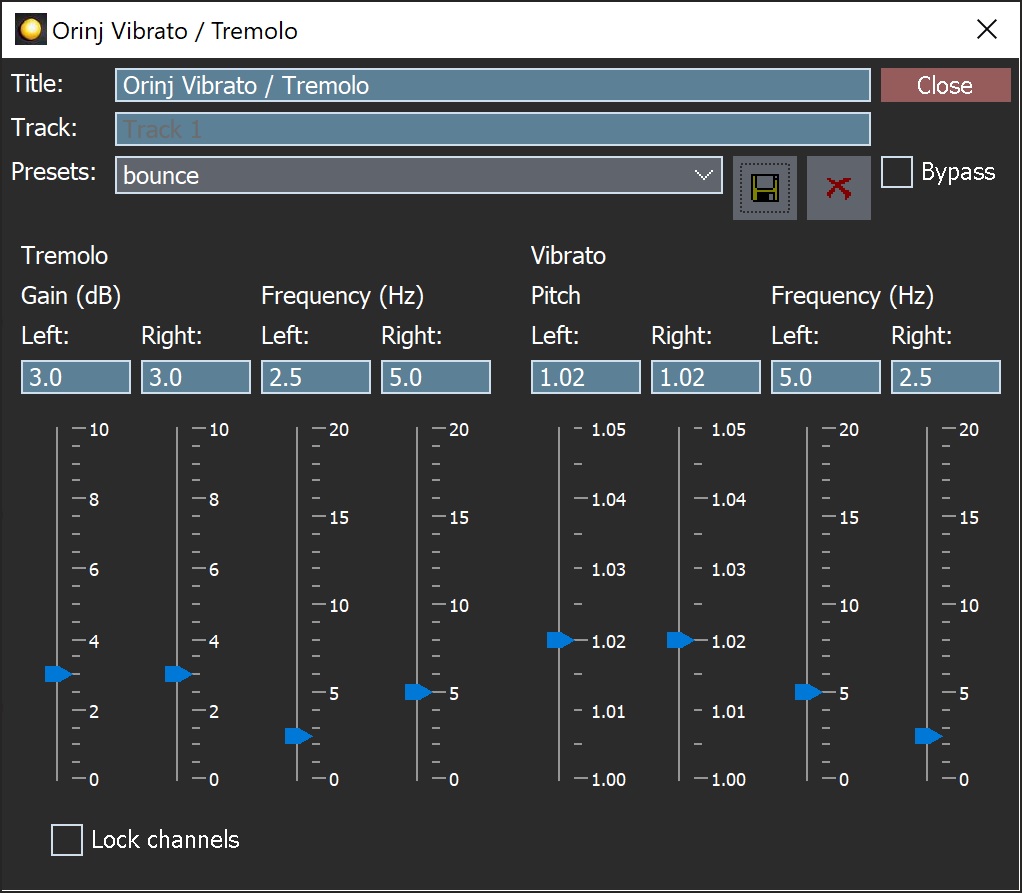Orinj version 7.0.0
The Orinj Vibrato and tremolo effect combines two effects – a vibrato and a tremolo. The vibrato introduces a periodic change in the gain of the signal. The tremolo introduces a periodic change in the pitch of the signal. Both effects can be used together or each effect can be used separately.
An example of the Orinj Vibrato and Tremolo
The following sound sample contains three repetitions of an acoustic guitar riff. The first repetition is as recorded, without vibrato or tremolo. The second repetition uses a vibrato with a maximum pitch change of 1.025 (about 43 cents) and an oscillation frequency of 5 Hz in both channels. The third repetition uses a tremolo with a maximum amplitude change of 3 dB and oscillation frequency of 5 Hz in both channels.
Click to play this example with vibrato and tremolo.
Using the Orinj Vibrato and tremolo
The Orinj Vibrato and tremolo can be added to tracks, auxiliary channels, and the master channel in the multitrack session view and to waves in the single wave view.
- To add the effect to a track in the session, first click on the track to select it. Click on Effect, Other, and then on Orinj Vibrato / Tremolo in the menu.
- To add the effect to an auxiliary channel in the session, click on Track, then Groups / Aux Channels, and then on Aux Channel Controls in the menu. In the auxiliary channel control dialog, click on the Add button.
- To add the effect to the master channel in the session, click on Track and then on Master Channel in the menu. In the master channel dialog, click on the Add button.
- To add the effect to a wave in the single wave view, click on Effect, Other, and then on Orinj Vibrato / Tremolo in the menu.
You will see the following dialog.

When this dialog becomes visible, the Orinj Vibrato and tremolo effect has been added. Adjust the parameters of the vibrato and tremolo in the dialog above and click Close. The parameters of this effect are described below.
Orinj Vibrato and tremolo parameters
See Orinj Effects for an explanation of the Title, Track, Presets, Bypass, and Lock channels controls. The remaining Orinj Vibrato and tremolo controls are described below:
- Vibrato left channel gain: Use these controls – the box and the slider – to set the maximum gain of the vibrato in the left channel. The gain is specified in decibels and can be between 0 dB and 10 dB. If, for example, the maximum gain is 3 dB, the gain applied to the left channel will oscillate between -3 dB and 3 dB. If the maximum is set to 0 dB, there will be no vibrato in the left channel.
- Vibrato right channel gain: Use these controls – the box and the slider – to set the maximum gain of the vibrato in the right channel.
- Vibrato left channel frequency: Use these controls – the box and the slider – to set the frequency, with which the vibrato gain in the left channel oscillates. The frequency is in Hertz and can be between 0 Hz and 20 Hz. If, for example, the left channel maximum vibrato gain is set to 3 dB and the left channel vibrato frequency is 5 Hz, then the vibrato gain will move between -3 dB and 3 dB five times in one second. If the frequency is set to 0 Hz, there will be no vibrato in the left channel.
- Vibrato right channel frequency: Use these controls – the box and the slider – to set the frequency of the vibrato gain low frequency oscillation (LFO) in the right channel.
- Tremolo left channel pitch: Use these controls – the box and the slider – to set the maximum pitch change of the tremolo in the left channel. The maximum pitch is a scale between 1 and 1.05. Suppose that the maximum pitch is set to 1.05 and the incoming signal is the frequency 440 Hz. The output frequency will change from 440 / 1.05 = 419 Hz to 440 * 1.05 = 462 Hz. Note that one semitone up or down (in an equal tempered scale) is a change in pitch of about 1.059 and so the maximum pitch change allowed in the tremolo is a little less than one semitone. If the maximum pitch is set to 1, there will be no tremolo in the left channel.
- Tremolo right channel pitch: Use these controls – the box and the slider – to set the maximum pitch change in the tremolo in the right channel.
- Tremolo left channel frequency: Use these controls – the box and the slider – to set the frequency, with which the tremolo pitch in the left channel oscillates. The frequency is in Hertz and can be between 0 Hz and 20 Hz. Suppose that the maximum pitch is set to 1.05 and the frequency is set to 3 Hz. Then the tremolo pitch will change between -1.05 and 1.05 three times in one second. If the frequency is set to 0 Hz, there will be no tremolo in the left channel.
- Tremolo right channel frequency: Use these controls – the box and the slider – to set the frequency of the tremolo pitch LFO in the right channel.
See Orinj Effects for additional notes on: where Orinj effects can be used, using boxes and sliders that impact the same parameter (such as the box and slider for the left channel delay), applying effects to mono and stereo waves, and using effects during playback. See Orinj Working with effects for additional information on creating, modifying, moving, and removing effects.

Add new comment